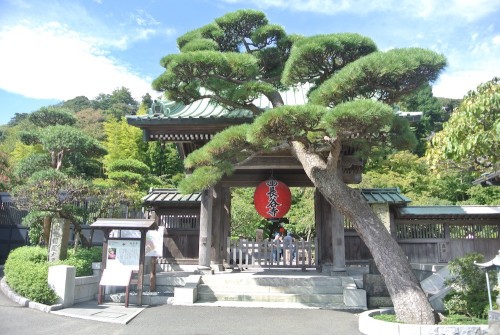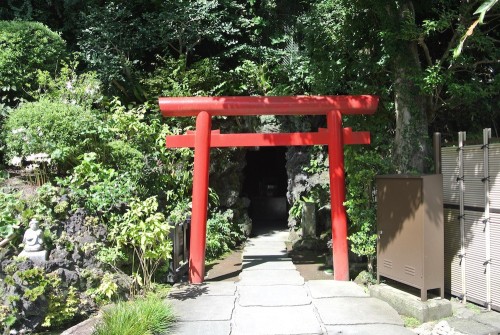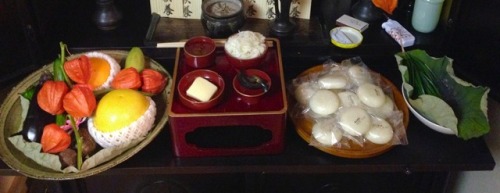#japanese buddhism
Explore The Wonderful Hase Temple in Kamakura
Hase Temple in Kamakura is famous for being the home of Japan’s largest wooden statue of the eleven faced Kannon Bodhisattva and for its beautiful hydrangea garden. Discover the views and the highlights of Hase Temple!
Post link
It’s Obon here in Kyoto, ancestors’ homecoming (or somewhat sober Halloween?). Obon is one of the two important events for Japanese in a year (the other is new year celebration), which often leads to family reunion for the living, too.
In Kyoto, people invite their ancestors’ spirits into home in the evening of August 12 with “muka'e'bi [moo-kah-eh-bee]” (literally meaning “inviting/welcoming fire”), and send ancestors back to the next world at the night of August 16 with “Gozan Okuribi [oh-coo-ree-bee]”, (“bonfires on five mountains for sending ancestors back”), according to lunar calendar. For Obon, people clean up their family graves beforehand, and confort and offer their hospitality to ancestors such as with foods and pray with monk’s sutras at home.
To invite ancestors, we do a little ritual “muka'e'bi” at home: burn dry hemp stems in front of the house, fire three stick incenses, and set it at the family’s Buddhist altar. Ancestors’ spirits are believed to “ride on” the special smoke of the incense, come into the house, and settle at the family’s Buddhist altar in a denser or more concrete form than usual (I’m not died and don’t know how it is actually, though).
We serve “omuka'e somen”, or “welcome somen noodle (angel-hair udon, so to speak)” for the first night. While Obon, vegetables and fruits, Chinese lantern plant, water on a lotus leaf with a sprig of Koya prodocarp (“Koya maki”/高野槙), mochi and/or dango (sweet dumplings), and sugar starch snacks (“rakugan”) are also displayed. Vegetarian dishes and steamed rice are served everyday until they leave. The dishes served are kept in the fridge and taken to the temple a family belongs to with other vegetables just when Obon ends (to send the foods with ancestors’ spirits precisely, or if you eat them, it’s believed you would get ill. Dishes and vegetables served during Obon are simply for the repose of the dead).
Since the Obon customs differ by region and denomination, I totally don’t know other styles. No “Bon dance” or “summer festival” is held in my neighborhood. No making horse and ox figures with vegetables and toothpicks. I’ve seen them only on TV. The case explained above is only of a certain family in Kyoto.
By the way, what about spirits who don’t have any descendants? …It’s said no home to go and loitering here and there. So people give a little service for the benefit of suffering spirits as well as avoid going to sea or river in fear of evil spirits during Obon.
Obon
http://www.japan-guide.com/e/e2286.html
https://en.m.wikipedia.org/wiki/Bon_Festival
Gozan Okuribi (mountain bonfire)
https://www.jnto.go.jp/eng/spot/festival/gozanokuribi.html
お盆の迎え火におがらを炊く。京都では8月12日の夕暮れに家の外で迎え火を焚いて先祖を家へ招き入れ、16日の夜の五山送り火で送り返す。お盆の最初の夜はお迎え素麺でもてなす。ちなみに野菜と爪楊枝で馬や牛を作ったりしない。近所では盆踊りも夏祭りもない。TVでしか見たことがない。関東では同じ宗派でも仏壇に水塔婆を立てないと聞いた。色々土地によって違うらしい。
Post link
Announcement
It’s time for a little Bukkyō-kōden [仏教公伝]!
I recently became a Gakuryo [学侶] of Fujidaiseki Temple [富士大石寺] in Shin-yokohama [新横浜] which is a class of Buddhist monk who dedicate most of their time studying the Lotus Sūtra or Hokekyō [法華経] in Japanese.
I made an account on Twitter and Tumblr where I blog Buddhist parables as well as verses from Lotus Sūtra both in English and Japanese.
So, please consider following! And I just want to ask one small favor, please include the prayer “Namu-myōhō-rengekyō” [南無妙法蓮華経] in the comment or when reblogging/retweeting. That would help me greatly by allowing the Dharma to reach wider audiences so that many more people can receive great amounts of blessings and compassion via the Lotus Sūtra.
Thank you in advance !
能遮学侶 (@ShoichiYajima) | Twitter
Rain Making In Japanese Buddhism
Surprisingly, early records of rain making are mostly conducted by Buddhist monks rather than Shintō priests/priestesses. In “Tōdaiji-gusho” [東大寺具書] (Nara Period?), the very first Buddhist monk who performed rain dance was a monk from the Kingdom of Koryŏ [高麗/고려] by the name of Ekan [慧灌] (Asuka Period) who is the founder of Sanron Buddhist Sect [三論宗] in Japan¹. While his stay in Hōkō Temple [法興寺] (today’s Asuka Temple [飛鳥寺] (below) in Asuka Village [明日香村], Takaichi Dist. [高市郡], Nara Period) during the reign of Emperor Kōtoku [孝徳天皇], a series of draught struck Japan. This was when Ekan performed a rain making ritual as he recited verses from Sanron scriptures while wearing a blue dress which successfully brought rain.

Another less successful attempt was recorded from year 642 via “Nihon-shoki” when Empress Kyōgoku [皇極天皇] (594-661) instructed nobleman Soga-no-Emishi [蘇我 蝦夷] (586?-645) to conduct a rain making ritual on July 25th as he recited verses from Māhayāna Buddhist scriptures, but was instructed to desist after four days for the rain he managed to summon were mere drizzles and proper rain came only when the Empress prayed herself.
There’s also a legend² when two monks battled over who could bring down rain. In 1261, Shingon Buddhist Sect [真言律宗] monk Ninshō [忍性] (1217-1303) (below left) of Gokuraku Temple [極楽寺] (Kamakura City [鎌倉市], Kanagawa Prefecture) and another monk called Nichiren [日蓮] (below right) (1222-1282) who later founded Hokke Buddhist Sect [法華宗] fought each other to prove who’s teachings were superior. When Ninshō called upon the rain, it ended up summoning a tempest and failed, but delicate rain came down from the sky when Nichiren did the same; resulting to Nichiren taking the W.


Based upon these accounts, rain making became an integral part of Japanese Buddhist practice such as the manual for rain making together with drums and strawhats used in the ritual stored in Shindaibutsu Temple [新大仏寺] (Iga City [伊賀市], Mie Prefecture).
新大仏寺雨乞い関係文書 附 雨乞い踊り用具 文化遺産オンライン
This is especially true for Jōdoshin Buddhists [浄土真宗] with their Nenbutsu-odori [念仏踊] which is a Buddhist choreography of rain making practiced even to this day such as the famous Taki-no-miya-nenbutsu-odori [滝宮の念仏踊] performed in Ayagawa Town [綾川町] (Ayauta Dist. [綾歌郡], Kagawa Prefecture).
Sources:
Two terracotta sculptures from the Hōryū-ji temple in Ikaruga (Nara), Japan.
These two sculptures are guardians, situated at each entry of the buddhist temple. Agyo, the red one with its mouth open represents expressed power andUngyo, the black one with its mouth closed represents latent power. They protect the temple against its ennemies and their fierce attitude is supposed to frighten off people with bad intentions.
photos by JapanPhotos.org.uk.
Post link
Tomiyuki Kaneko—Apotropaic Daruma (transparent watercolor, pen, foil on Shirakawa Daruma, 2021)
Post link







